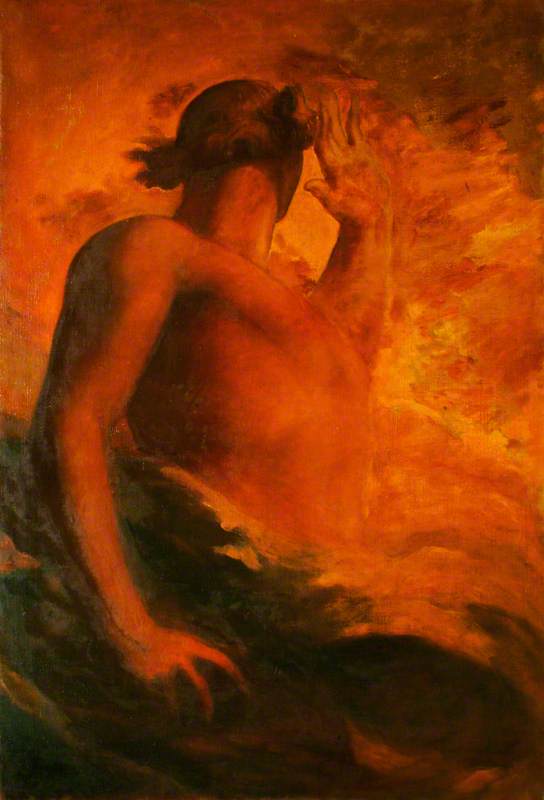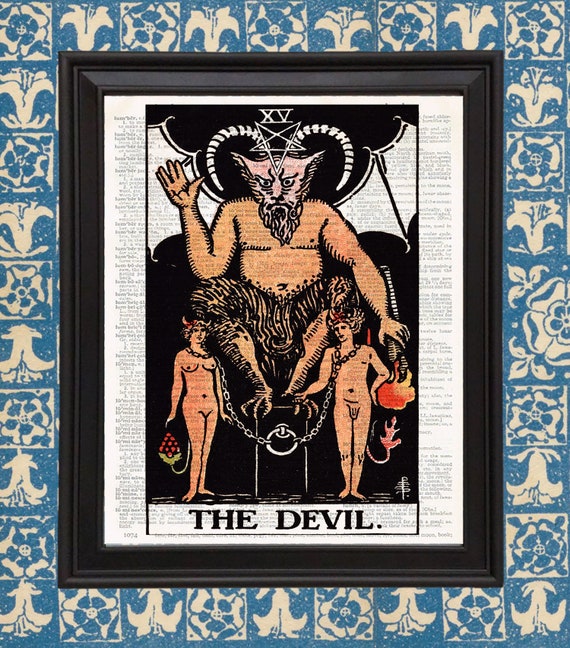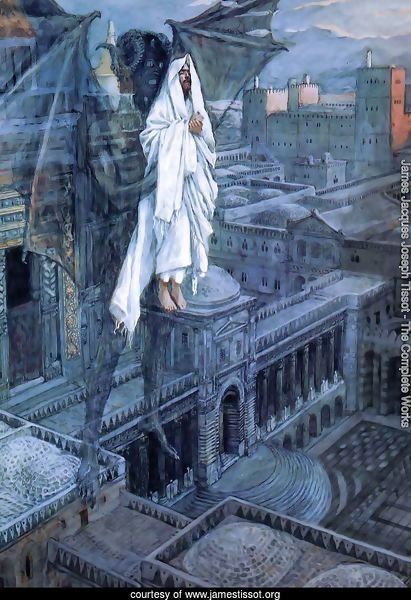Apparently the idea of the Devil changed around the time of the French Revolution, and with the publication of Paradise Lost, which - I’m not sure if intentionally - turned Satan from a monster and demon into a sort of tragic anti-hero, a rebel battling against a cruel overlord, in the same way, I guess, French and other European poor saw themselves as locked in a struggle with their richer masters. So the Devil becomes a figure of resistance, standing up to the big guy, and in the process can’t be painted as a beast or a demon, so takes on more human characteristics. This of course would not last - the Church would not stand for anyone humanising the Devil! - and soon after this the accepted form of the devil - horns, tail, wings, red skin etc - was re-established, and has remained our image of him ever since.
Staying with the rebel notion though, sculptor Jean-Jacques Feuchère had him as a brooding, contemplative figure, the idea perhaps of his wings being folded over him indicating he was not about to cause anyone any harm, nor indeed take flight, but was thinking about what he had done and what it meant for him, and how he intended to go on. The face - what you can see of it - looks vaguely monstrous, though it could just be an ugly one, perhaps the result of his Fall - and really if anything he’s the Fallen Angel in this one, much more than the goat-legged Devil or misshapen monster of the fifteenth century.

George Frederic Watts’ 1847 Satan gives us almost a non-image of the Devil, as he is seen looking away, so we can’t see his face, but even at that, his body is human and proportioned like one, and it’s unlikely his face is going to be that of a beast. He certainly has no horns and no wings. But by the nineteenth century we’re back to the idea of the Devil as a kind of goat-man, as certainly made popular due to the interest in and sale of tarot cards, which used the basic idea of Baphomet as their template.

The thing about Baphomet is that the creature is not really anything to do with the Devil. It is in fact another very ancient symbol that dates back to about the tenth century, and is more closely tied in with magic (not necessarily black magic, but probably more so that) than any real Satanic connection. Nevertheless, it has become, if you like, appropriated as a symbol of the Devil, and I have to say, some heavy metal bands have to admit to their share of blame for that, as Baphomet is used by quite a few, especially NWOBHM not-quite-superstars Angel Witch, who used it both in a song title and on the cover of that single. But Baphomet, originally believed to have been worshipped by the Knights Templar, seems to be more of a symbol of unity than chaos - the idea of bringing together two disparate opposites and melding them together. The first real image of Baphomet to be seen was drawn in 1856 by Elias, an occultist, and later bastardised into a symbol of satanism by another, more famous (or infamous) magician, Aleister Crowley.
Personally, I think Baphomet looks cute: always looks as if he’s waving and saying hello. Nice guy. Just keep him away from pentagrams, black candles and virgins.
I can’t say I think much of Jean Jacques Joseph (JJJ? Surely not!) Tissot’s mid-nineteenth century depiction of Satan tempting Jesus in the wilderness. I mean, he just seems to be an old man with brown skin, quite small and shrivelled up looking. Certainly does not look like any sort of threat, more like someone who, as we say here, you’d give tuppence to. I suppose the idea the artist was trying to get across was the insignificance and futility of the Devil tempting the Son of God; Jesus doesn’t even seem to notice him.
He does somewhat better in his later painting where Satan carries Jesus to the top of the mountain and shows him all the kingdoms of the earth, trying to get him to acknowledge him as the master of the world; Jesus of course tells him where to stick it. But here he’s a grey, shadowy figure, almost translucent, kind of as if he’s made of smoke or stone, with the by-now traditional bat wings spread as he hovers, though his face is left pretty nondescript, almost blank. Still, it’s better than a beggar in the mouth of the cave.

What’s even more interesting about this painting, compared to the other one, is the reversal of sizes. In the first one, Jesus is much larger and taller than Satan - yes, he’s drawn in the foreground and the Devil is on his knees (an odd kind of posture for one supposed to be tempting, but let that go), but you can still see the difference in sizes. Satan is small, shrivelled, almost pathetic, and brown, to merge with the dirt of the cavern floor, whereas Jesus is brilliant in white. He’s still in white in the second image, but Satan, behind him, is about twice his size, literally holding him up. This one, I think, perhaps deliberately, changes the relationship between the two and makes Jesus look almost vulnerable. Of course, we know that were he to fall he would not die - this is not part of his father’s plan - but you still get the impression of danger, which you did not from the other painting.
It’s also a clever touch that Satan is coloured the same as the buildings around him (hold on, wasn’t this supposed to be a mountain? Artistic licence, I guess) so that not only does he kind of blend into them, we get the feeling that, as he says, he does own them; he is part of the world, master even of it, but Jesus, standing starkly white against the brickwork, looks to be separate, not part of this sordid world, destined for greater things, unconcerned, aloof, untouchable. Oh, I see the Devil first took him up to the top of the temple in the Holy City, which is where this is set, before going up the mountain. Fair enough. I wonder if the fact that the figure of the Devil is sort of blending with the city is meant to suggest impermanence, that his evil, his power is fleeting, whereas that of God is eternal?